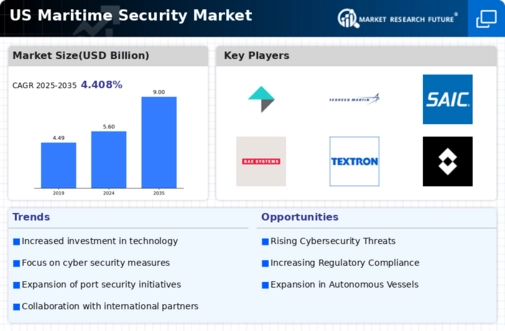Increased Regulatory Compliance
The maritime security market is significantly influenced by the need for increased regulatory compliance. Governments and international organizations have implemented stringent regulations aimed at enhancing maritime safety and security. For instance, the U.S. Coast Guard has established the Maritime Transportation Security Act, which mandates security measures for vessels and port facilities. Compliance with these regulations often requires substantial investment in security infrastructure, thereby driving growth in the maritime security market. It is estimated that compliance-related expenditures could account for up to 20% of total operational costs for shipping companies. As regulations continue to evolve, the demand for innovative security solutions that meet these requirements is likely to rise, further propelling the maritime security market.
Rising Threat of Maritime Piracy
The increasing threat of maritime piracy has emerged as a critical driver for the maritime security market. In recent years, incidents of piracy have surged, particularly in regions such as the Gulf of Aden and the Strait of Malacca. This escalation has prompted shipping companies and governments to invest heavily in security measures. The maritime security market is projected to grow at a CAGR of approximately 7.5% from 2025 to 2030, driven by the need for enhanced surveillance and protection of vessels. As a result, companies are increasingly adopting advanced technologies such as drones and satellite monitoring systems to mitigate risks associated with piracy. This trend underscores the importance of robust maritime security solutions in safeguarding trade routes and ensuring the safety of maritime operations.
Expansion of Maritime Trade Activities
The expansion of maritime trade activities is a key driver influencing the maritime security market. As global trade continues to grow, the volume of goods transported by sea is increasing, necessitating enhanced security measures. The U.S. maritime trade is projected to reach $1 trillion by 2026, which underscores the importance of securing maritime operations. This growth presents both opportunities and challenges for the maritime security market, as the need for effective security solutions becomes more pronounced. Companies are likely to invest in comprehensive security strategies, including risk assessments and incident response plans, to safeguard their assets. Consequently, the maritime security market is expected to experience robust growth, driven by the rising demand for security solutions that can address the complexities of modern maritime trade.
Growing Demand for Port Security Solutions
The growing demand for port security solutions is a significant driver of the maritime security market. As ports serve as critical nodes in global trade, ensuring their security has become paramount. Recent statistics indicate that over 90% of global trade is conducted via maritime routes, highlighting the necessity for robust security measures at ports. Investments in surveillance systems, access control, and threat detection technologies are on the rise, with the port security segment expected to account for a substantial share of the maritime security market. It is anticipated that this segment will grow at a CAGR of approximately 6% through 2030, driven by the need to protect against potential threats such as terrorism and smuggling.
Technological Integration in Maritime Operations
The integration of advanced technologies into maritime operations is a pivotal driver for the maritime security market. Technologies such as artificial intelligence, machine learning, and the Internet of Things (IoT) are being increasingly adopted to enhance security measures. For example, AI-driven analytics can predict potential threats and optimize response strategies, while IoT devices enable real-time monitoring of vessels and cargo. The maritime security market is expected to witness a substantial increase in investment in these technologies, with projections indicating a growth rate of around 8% annually over the next five years. This technological evolution not only improves security but also enhances operational efficiency, making it a crucial factor in the maritime security market.



















Leave a Comment